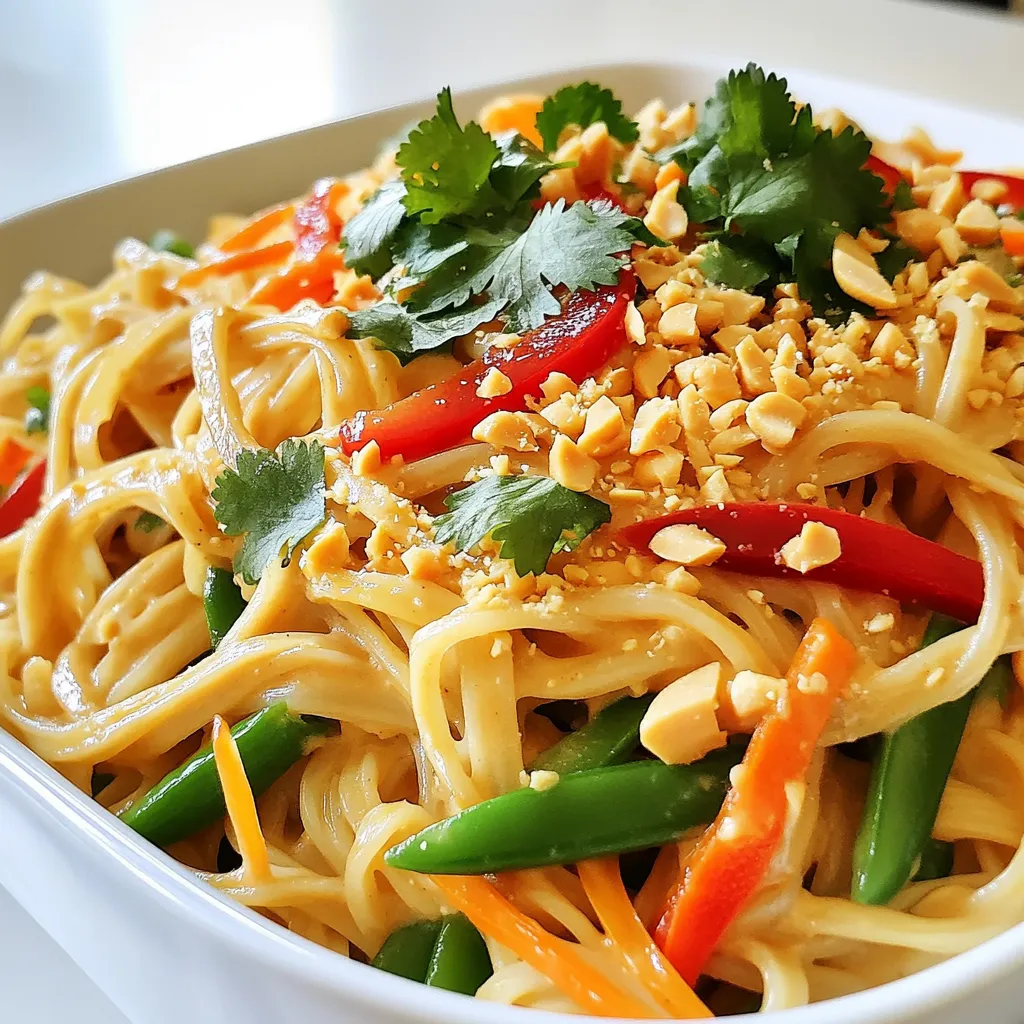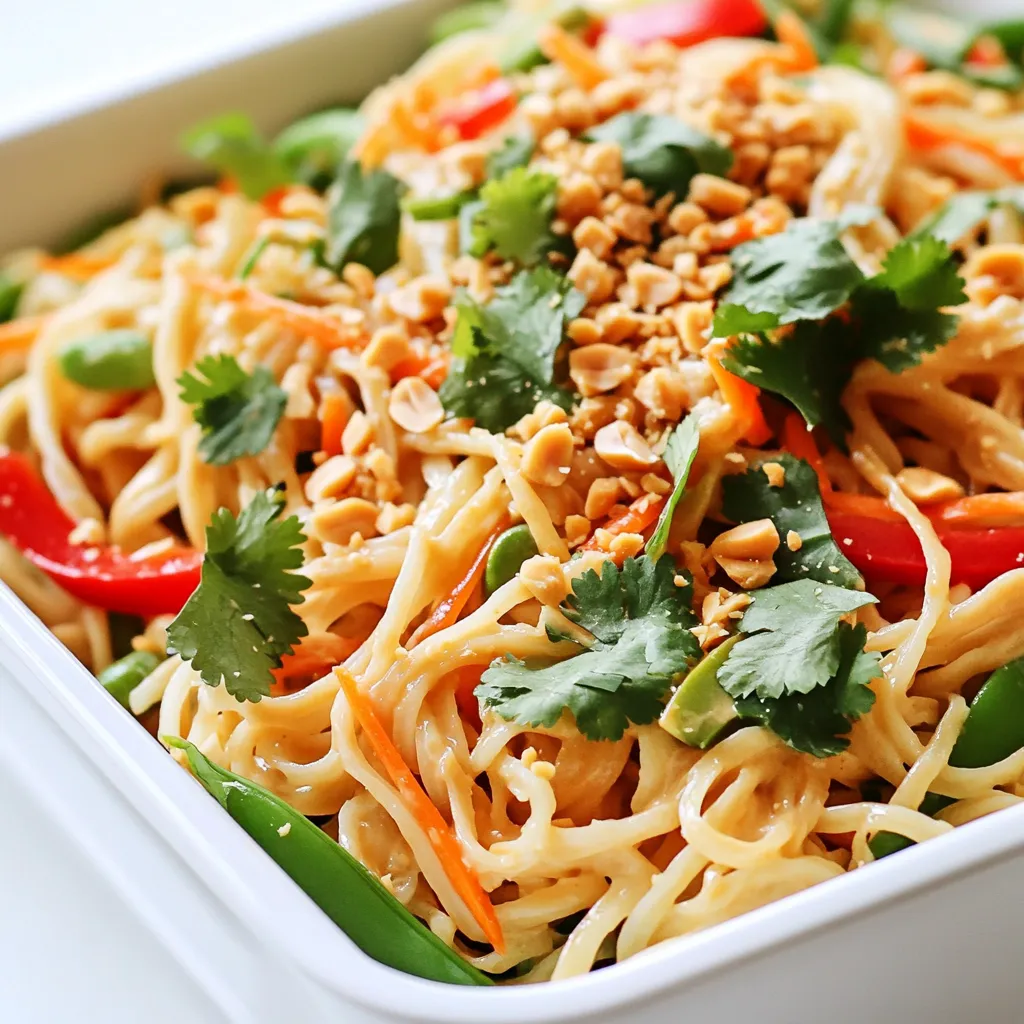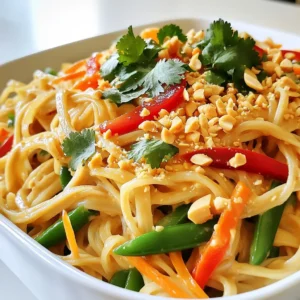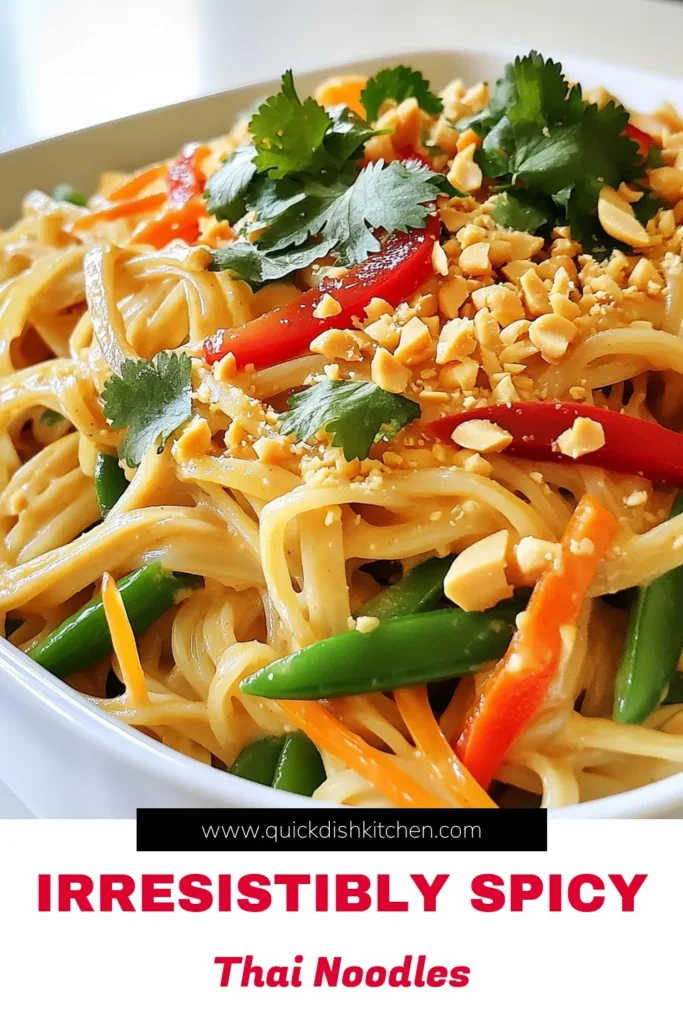Craving a quick and tasty meal? Spicy Thai Peanut Noodles are the answer! This dish mixes creamy peanut sauce with rice noodles and fresh veggies for a burst of flavor. Plus, you can make it just right for your taste buds. In this guide, I’ll share easy steps, ingredient swaps, and helpful tips. Get ready to impress yourself with a dish that’s simple yet packed with taste!

Ingredients
List of Key Ingredients
To make Spicy Thai Peanut Noodles, you need the following key ingredients:
– 8 oz (225 g) rice noodles
– 1 cup creamy peanut butter
– 3 tablespoons soy sauce (or tamari for gluten-free)
– 2 tablespoons lime juice
– 1 tablespoon brown sugar
– 1-2 teaspoons sriracha (adjust based on spice preference)
– 1 cup coconut milk
– 1 red bell pepper, sliced thinly
– 1 cup shredded carrots
– 1 cup snap peas
– 3 green onions, chopped
– 1 tablespoon sesame oil (for cooking)
– Crushed peanuts and chopped cilantro for garnish
These ingredients give the dish a rich flavor and great texture.
Common Substitutes
If you can’t find some ingredients, here are some common substitutes:
– Rice noodles: Use any thin noodles like spaghetti or soba.
– Soy sauce: Replace with coconut aminos for a soy-free option.
– Creamy peanut butter: Almond or cashew butter works too.
– Coconut milk: Use heavy cream or dairy-free milk if needed.
– Sriracha: Hot sauce or chili paste can be used instead.
These swaps will still keep your noodles tasty.
Optional Garnishes
To add a finishing touch, consider these optional garnishes:
– Crushed peanuts for crunch
– Chopped cilantro for fresh flavor
– Lime wedges for a zesty kick
These garnishes enhance the flavor and look of your dish.
Step-by-Step Instructions
Preparing the Rice Noodles
To start, boil water in a large pot. Once it bubbles, add 8 oz of rice noodles. Cook them according to the package directions until they are al dente. This usually takes about 4 to 6 minutes. After cooking, drain the noodles in a colander. Rinse them under cold water to stop the cooking process. Set the noodles aside while you prepare the sauce and vegetables.
Making the Peanut Sauce
In a medium mixing bowl, combine 1 cup of creamy peanut butter, 3 tablespoons of soy sauce, and 2 tablespoons of lime juice. Add 1 tablespoon of brown sugar and 1 to 2 teaspoons of sriracha, depending on how spicy you want the dish. Pour in 1 cup of coconut milk. Whisk everything together until it is smooth and well-mixed. This sauce will give the noodles their rich flavor.
Sautéing the Vegetables
Now, heat 1 tablespoon of sesame oil in a large skillet over medium heat. Add thinly sliced red bell pepper, shredded carrots, and snap peas. Sauté for about 5 minutes. You want the veggies to be tender but still crisp. This step adds great texture and flavor to the meal.
Combining Everything Together
Once your vegetables are ready, it’s time to add the noodles. Place the cooked rice noodles into the skillet with the veggies. Pour the peanut sauce over the top. Toss everything together gently. Make sure the noodles are well-coated in the sauce. Heat everything through for a couple of minutes.
Serving Suggestions
Remove the skillet from the heat. Stir in chopped green onions for a fresh touch. Portion the noodles into bowls. Top each bowl with crushed peanuts and chopped cilantro. This adds crunch and a burst of flavor. Enjoy your Spicy Thai Peanut Noodles hot for a quick and tasty meal!
Tips & Tricks
How to Achieve the Perfect Sauce Consistency
To get the sauce just right, mix the peanut butter with coconut milk first. This keeps the sauce smooth. If it feels too thick, add a bit more coconut milk. You want it creamy but pourable. The lime juice helps balance flavors and adds a fresh taste. Adjust the sriracha for more heat. If you want it sweeter, add a bit more brown sugar.
Cooking Tips for Noodles
When cooking rice noodles, always check the package for timing. They can turn mushy if overcooked. After boiling, rinse them under cold water to stop the cooking. This keeps them firm and prevents clumping. Toss the noodles with a little sesame oil right after cooking. This adds flavor and keeps them from sticking together.
Spice Level Adjustments
To change the spice level, simply adjust the amount of sriracha. Start with one teaspoon if you like it mild. You can always add more later. If you want a cooler dish, serve it with lime wedges. This adds freshness without the heat. If you prefer more spice, try adding chili flakes or a dash of hot sauce when serving. This gives you control over your heat level.

Variations
Adding Proteins (Chicken, Tofu, Shrimp)
You can customize your Spicy Thai Peanut Noodles by adding proteins. Chicken, tofu, or shrimp works well. For chicken, cook bite-sized pieces until golden. Add them to the noodles after sautéing the veggies. If using shrimp, cook them until pink and tender. Tofu is an excellent choice for a vegan meal. Sauté cubed tofu until crisp before mixing it in. This not only adds protein but also enhances flavor.
Alternative Vegetables
Feel free to mix in different vegetables for variety. Broccoli, bell peppers, and zucchini are great options. You can also try baby corn or bok choy for a fun twist. Just remember to cut them into small pieces. This helps them cook evenly. Sauté the veggies until they are bright and crisp. More veggies mean more color and nutrients in your dish.
Gluten-Free and Vegan Options
If you need gluten-free options, use tamari instead of soy sauce. Rice noodles are naturally gluten-free, making this dish easy to adapt. For vegans, ensure your peanut butter is free from animal products. Also, check that the sugar is vegan-friendly. Coconut milk adds creaminess without dairy. With these simple swaps, you can enjoy this dish while meeting your dietary needs.
Storage Info
How to Store Leftovers
Store any leftovers in an airtight container. Place the noodles in the fridge. They stay fresh for about three days. Make sure to cool them before sealing. Keeping them in the fridge helps keep flavors intact.
Reheating Instructions
Reheat the noodles in a skillet over medium heat. Add a splash of water or coconut milk for moisture. Stir until the noodles are warm. You can also use a microwave. Heat them in a bowl for one to two minutes. Stir halfway to make sure they heat evenly.
Freezing Spicy Thai Peanut Noodles
You can freeze the noodles if you want to save them for later. Place them in a freezer-safe container. They will keep for up to two months. To thaw, move them to the fridge overnight. Reheat as mentioned above. Keep in mind that veggies may lose some crunch after freezing.
FAQs
What can I use instead of rice noodles?
If you can’t find rice noodles, you can use other types of noodles. Some good options are:
– Spaghetti: This is a common choice. It has a similar texture.
– Soba noodles: These are made from buckwheat. They offer a nutty taste.
– Zucchini noodles: Also known as zoodles, they are a great low-carb option.
– Whole wheat noodles: These add more fiber and are a healthier choice.
Each noodle type gives a different flavor and texture.
How spicy are Spicy Thai Peanut Noodles?
The spice level of these noodles can vary. The recipe calls for 1-2 teaspoons of sriracha. If you like more heat, add extra sriracha. Start with one teaspoon, then taste. You can always add more. If you prefer mild flavors, use less sriracha for a lighter dish.
Can I make the sauce ahead of time?
Yes, you can make the sauce ahead of time. Just mix the peanut butter, soy sauce, lime juice, brown sugar, sriracha, and coconut milk. Store it in the fridge in an airtight container. The sauce will stay fresh for about three days. When you are ready to cook, just heat it up.
Is there a vegetarian version of this recipe?
Yes, this recipe can easily be vegetarian. Simply use soy sauce or tamari for a gluten-free option. All the other ingredients are already vegetarian-friendly. To add protein, consider adding tofu or tempeh. Both work well with the sauce and noodles.
What are the nutritional values of Spicy Thai Peanut Noodles?
The nutritional values may differ based on your specific ingredients. Here is a rough estimate per serving:
– Calories: 450-500
– Protein: 12-15g
– Carbohydrates: 50-55g
– Fat: 24-28g
– Fiber: 5-7g
For the best results, check the labels of your specific brands. Adjustments can change these values.
In this blog post, I walked you through making Spicy Thai Peanut Noodles. We covered essential ingredients, substitutes, and optional garnishes. You learned how to prepare rice noodles, make a rich peanut sauce, and sauté fresh veggies. I shared tips for perfecting the sauce and adjusting spice levels.
Feel free to try variations with proteins and different vegetables. Store leftovers correctly for future meals. With this guide, you can enjoy this dish anytime. Happy cooking!


